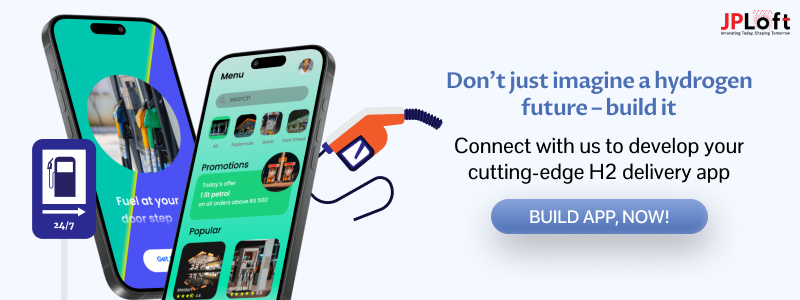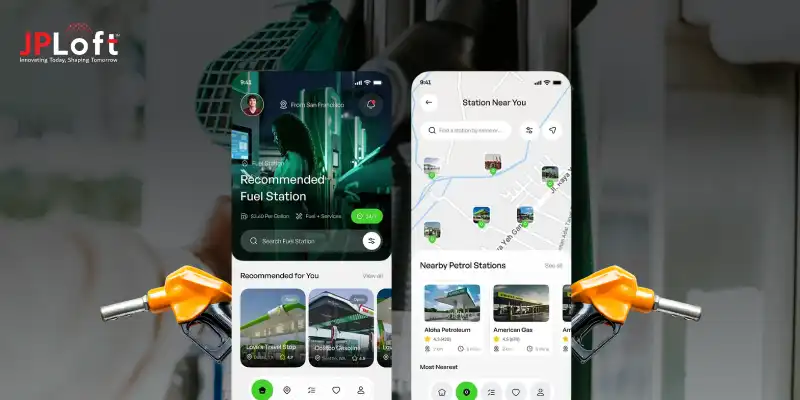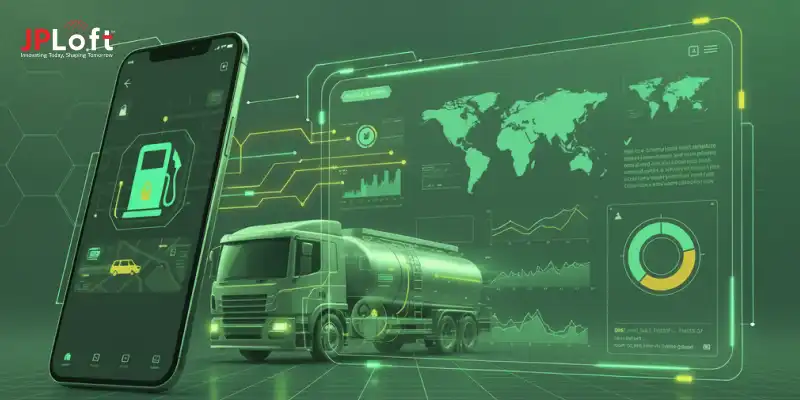Have you ever thought of green fuel, such as hydrogen?
Well, various hydrogen fuel stations provide such a facility to the customers, but have you ever thought of improving the lives of people while creating a delivery app?
This can create an opportunity for you to successfully lead the industry by entering the market.
As the world pivots towards a sustainable future, hydrogen isn't just a fuel – it's a paradigm shift.
In this blog, you can explore it all from the concepts, stats, steps to build a hydrogen fuel delivery app, AI implementation, features, and much more.
Are you ready to proceed?
Yes!
Well, let's count all the headings one after the other.
Key Takeaways:
-
Hydrogen fuel delivery apps offer convenient, on-demand refueling, improving user experience and accessibility.
-
The hydrogen fueling station market is rapidly growing, presenting a lucrative investment opportunity for businesses.
-
Hydrogen is a future fuel due to its zero emissions and high energy density, promoting environmental sustainability.
-
Integrating AI into hydrogen fuel apps enables smart features like optimized routing, demand forecasting, and enhanced security.
Developing such an app allows for diverse monetization strategies, including delivery fees and subscription plans.
What is a Hydrogen Fuel Delivery App?
A hydrogen fuel delivery app is like any other fuel delivery app; the only difference you will find is, it delivers hydrogen. It connects users with suppliers for convenient, doorstep refueling of hydrogen-powered vehicles or equipment.
This app functions similarly to a traditional gas station, but instead of gasoline or diesel, the station provides hydrogen.
Other than this, you should be aware of hydrogen fuel stations, helpful in deciding the business model.
A hydrogen station can be known as a hydrogen refuelling station, which offers a facility to dispense hydrogen fuel to power fuel cell vehicles (FCVs).
Let’s look ahead to some of the stats below.
-
The global hydrogen fueling station market size was estimated at USD 832.2 million in 2024, and is expected to grow at a CAGR of 26.3% from 2025 to 2030.
-
As per the fuel delivery market statistics, the Asia Pacific region holds the largest revenue share of over 63% in 2024.
-
Additionally, China has the greatest number of hydrogen fuel stations of any country worldwide, followed by South Korea and Japan.
-
As of 2024, there are over 54 open retail hydrogen stations in the United States. There are over 20 stations in various stages, and most of them are existing in California and Hawaii.
Following these stats, let's begin with the reasons why hydrogen is the next future fuel.
Let’s find it all out in the section below.
3 Reasons Why Hydrogen is a Future Fuel
When you proceed to start an online fuel-delivery business, it's important to know why to invest in hydrogen.
Here’s a list to follow.
A] Zero Greenhouse Gas Emissions
Hydrogen fuel is produced from diversified domestic resources with the potential for near-zero greenhouse gas emissions.
Additionally, once produced, hydrogen can generate electric power in a fuel cell, emitting only water vapor and warm air. It holds promise for growth in both the stationary power and transportation energy sectors. Thus, it's a sustainable investment.
B] High Energy Density
Hydrogen fuel has a high density and combusts quickly that even at high temperatures. Additionally, when you combine it with the oxygen, it ignites and forms water as well as releases heat.
Hydrogen does provide a lot of energy per unit of mass, and does take up a lot of space for the amount of energy it stores and contains.
C] Optimized Storage Solutions
With hydrogen fuel, you can find optimized storage solutions, irrespective of any other liquid fuels. You can store hydrogen as a compressed gas that does require high-pressure tanks, often 350-700 bar.
If you select to invest in hydrogen as a business, it will help you to have an option of optimized storage.
Considering these reasons, are you ready to invest in diversified fuel station businesses?
Well, let’s focus on the following section.
Business Models to Start a Hydrogen Fuel Station Business
Confused about where to proceed- build a fuel delivery app or start a hydrogen fuel station?
Then, let's look forward to the business models below.
1. On-Site Production & Dispensing Model
This model is all about the stations that are developed at a particular site. Here, you can start the business by establishing a hydrogen fueling station and then serving the users according to their needs at the station.
2. Hydrogen Fuel Station Finder App
Another business model that you can adopt is a hydrogen fuel station finder app. Here, you can help the users find the nearby fuel stations. This is all about creating an app to engage the users towards your fueling station.
3. Hydrogen Fuel Delivery App
The hydrogen fuel delivery app is all about creating an application that is effective for helping users to get hydrogen fuel anytime, anywhere. This app can be developed to target the users who require hydrogen and can’t take their vehicles to the stations under any circumstances.
Well, you can look for the different other business models apart from the ones mentioned above, such as the owner-operator model, the Joint Venture, the third-party operator model, and the public-private partnership model.
Now, if you are the one looking to create a hydrogen fuel delivery app, then the following sections can help.
Why Create a Hydrogen Fuel Delivery App?
Prior to switching to the hydrogen fuel delivery app development, let’s learn in depth about why proceed with the same.
Let’s evaluate it all in this section.
► Growing Need for Hydrogen Fuel
There are many apps, including the HNO green fuel, that are providing sustainable fuel options to users so that they can move towards saving the environment.
Do you know that the market for hydrogen generation is estimated to grow at a CAGR of 9.2% from the year 2025 to 2030?
With these growing market stats, you can step into adapting this opportunity to start your dream business.
► Offers Convenience and Saves Time
A fuel delivery app can help you target the audience who prefer convenience over going to the stations for refilling fuel.
Along with this, the primary advantage of the app is that it offers fuel at the doorstep, having hydrogen delivered directly to the user’s location.
With convenience, the app saves the time of the users to successfully assist in optimizing fuel.
► Encourage the Use of Green Fuel
Building an H2O app can help you promote the concept of green fuel.
In this current era, where our ozone layer is depleting day by day, it's essential to come up with a concept that saves the environment by lowering the pollution level.
Hence, creating a hydrogen fuel delivery app can help you to spread awareness among the audience related to switching to sustainable fuel.
► Overcome Hydrogen Fuel Station Expenses
If you start a business, considering the option of developing an app is one of the crucial aspects to follow.
Here, you can overcome the expenses of creating a hydrogen fuel station and even placing it in a diversified location.
You can simply invest in good containers and safe vehicles to deliver hydrogen to the people who are in need of the same.
Well, these are some of the reasons to consider when it comes to building an on-demand hydrogen fuel station.
Now, as you are ready to create an app, let's proceed with the following section.
Features to Include in a Hydrogen Fuel Delivery App
What are the key fuel delivery app features to include here?
Well, let’s consider the given list of features that you can include within a hydrogen fuel delivery app.
► Admin Panel Features
-
User Management: You can consider the user management as one of the crucial features, helpful to add, delete, and even manage the user accounts, roles, and permissions.
-
Configuration settings: Managing the application settings, such as the language, security options, and more.
-
Data Analysis and Reporting: With the help of the fuel stations app, you can analyse the complete data and proceed with reporting.
-
Security Management: Implementing security measures, such as role-based access, authorization, encryption, and protecting the user data.
► User Panel Features
-
Fuel Ordering and tracking: With the help of AI in the hydrogen fuel delivery apps, users can order and even track their fuel.
-
Payment and Support: You can include multiple payment options like credit/debit cards, and potentially a cash-on-delivery option for the user's feasibility.
-
Real-time Tracking: You can use AI in the apps to help users track their ordered fuel in real-time.
-
Push Notifications: Push Notifications can help users get real-time information related to any current updates on fuel.
-
Location-Based Ordering: GPS tracking in the fuel delivery app influences the users’ experience and impacts their ability to successfully get their fuel for vehicles.
► Additional Features
-
Use of AI: In this competitive era, you cannot think of an app without including AI, as it helps in providing more personalized services to the users.
-
Vehicle Information: The users can evaluate the vehicle information once they book the fuel.
-
Vendor panel: Over the app, the users can even check the detailed information about the vendors who are providing fuel.
-
In-App Communication: You can include the feature of social sharing, helping the users to share their orders via different platforms.
Well, after considering these features, let’s proceed to evaluate the process to create a delivery app for hydrogen fuel in the following section.
How to Build a Hydrogen Fuel Delivery App?
Want to create an H2O app with a simple procedure?
Let’s consider the following steps in brief.
Step 1: Conduct an In-Depth Market Study
It is important to proceed with in-depth market research, which includes gathering data through feedback, surveys, polls, and interviews, along with focus groups.
This step will help you identify the target audience and then segment the users based on their demands. It will even help to frame the further strategies related to marketing the app, and creating or maintaining it.
Market study will help you to validate the app idea by creating a basic version of the minimum viable product (MVP).
Step 2: Build the MVP Version
Without an MVP version for your app, you cannot proceed in the market, as it is the step that will help you to validate your fuel delivery app idea.
This version of the app is important to consider for including the keywords that can help you succeed in the environment.
It comprises identifying the core features and then launching the app as per the users’ preferences. Later, you can include the feedback of the users and then improve its performance.
Step 3: Select the Top Features
When it comes to a hydrogen fuel delivery app, you should be selective when it comes to features, as it depicts the blood of your project.
Feature selection should be based on factors such as the project aim, considering the users' demand, and the current trends of the market.
It is an important step to proceed when you have to make a difference among the competitors. This step can help you to enhance your app’s presence and attract potential users.
Step 4: Build the Design of the App
Now, it's important to proceed with the UI/UX app design. This step is all about building an app wireframe, where you can create a blueprint of your project.
Here, another process is to create an app prototype. What you can do is build a visual representation of the app’s design along with the functionality and user interactions.
You can create a fuel delivery app design by evaluating the typography, color, theme, and even the font of your app’s content.
Step 5: Create the Core Functionality
You should learn about the core functions of the app, which include a complete backend process, such as code, languages, and even the database, or the cloud interface.
The fuel delivery app tech stack needs to comprise all the details related to front-end technologies like react native, or the use of JavaScript for your app.
You should remember that these technologies need to be supportive of your selection features.
Step 6: Develop, Test, and Launch
Here, you should combine all the selected steps and build your app. Hire dedicated developers to convert your dream app into reality.
After development, you should continue with the mobile app testing landscape. The testing should be of performance, usability, security, etc.
You should conduct testing under the real-world case scenarios, and select the appropriate testing tools for automation, performance testing, and other specialized testing types. Later, launch it over the defined platforms (Android, iOS, or both)
This was the world of normal app development, but now let's turn to that exciting bend where AI will shape the future of hydrogen fuel delivery apps!
Create a Hydrogen Fuel Delivery App with AI
Can you skip to create an AI app in this fast-changing world?
Well, no!
Under this step, you should leverage the tools that will help you build the hydrogen fuel delivery app from initial design and code to generation testing and content creation.
Hence, in this section, let’s learn about building a hydrogen fuel delivery app via AI in the table below.
|
Step |
AI Integration & Role |
|
Market Research & Planning |
Demand Forecasting: Predict demand, locations, and pricing. |
|
Feature Definition |
Personalization: Smart refueling recommendations. Predictive Maintenance: Fleet alerts. |
|
UI/UX Design |
Intuitive Experience: AI-driven adaptive interfaces. |
|
Backend Development & Tech Stack |
Route Optimization & Dispatch: Real-time logistics. Inventory Management: Automated stock control. |
|
Integration & Development |
Security: Fraud detection. IoT Processing: Real-time monitoring from sensors. |
|
Testing & Quality Assurance |
Automated Testing: Efficient bug detection, usage simulation. |
|
Deployment & Maintenance |
Performance Monitoring: Identify issues. Adaptive Updates: Data-driven improvements. |
Well, whether you create your app with ChatGPT or Gemini, all you will require is the right guidance. With AI app development services, you can achieve this objective.
Now the question is whether adopting AI for a hydrogen fuel delivery app can make a difference in your budget or cost?
Let’s evaluate it all in the proceeding section.
Cost to Create a Hydrogen Fuel Delivery App
The cost to build a fuel delivery app does create a difference, if you evaluate how many factors impact the same.
Here, the cost can vary from $15,000 to $60,000 based on the diversified factors, including artificial intelligence, complexity of app, design, tech stack, team of developers, security tools, and maintenance tools.
Let’s discover them all in the table given below.
|
Factor |
Cost Range (USD) |
Notes & Impact |
|
Artificial Intelligence |
$3,000 - $15,000 |
Basic AI: Simple recommendation engines, basic data analytics. Medium AI: Route optimization, predictive demand. Advanced AI (e.g., complex predictive maintenance) will push beyond this range. |
|
App Complexity |
$8,000 - $30,000 |
Basic: Core ordering, GPS tracking, and payment. Medium: Admin panel, driver app, multiple user roles, basic analytics. Advanced features (complex integrations, custom animations) will exceed this. |
|
Design (UI/UX) |
$3,000 - $10,000 |
Basic: Standard templates, minimal custom graphics. Medium: Custom elements, intuitive flow. Highly custom or intricate designs increase cost. |
|
Tech Stack |
$4,000 - $12,000 |
Cross-platform (Flutter, React Native) is more cost-effective. Native development (Swift/Kotlin) is higher. Includes backend (Node.js, Python), database (PostgreSQL, MongoDB), and cloud services (AWS, Azure). |
|
Team of Developers |
$7,000 - $25,000 |
Highly dependent on location (e.g., India/Eastern Europe developers are more cost-effective). Includes project managers, mobile developers, backend developers, and QA. |
|
Security Tools |
$1,000 - $3,000 |
Includes secure authentication (OTP, 2FA), data encryption (SSL), and basic vulnerability scanning. Higher-level penetration testing or ongoing security monitoring adds more. |
|
Maintenance Tools |
$1,000 - $5,000 |
Annual cost, typically 15-20% of development. Includes bug fixes, performance monitoring, server upkeep, minor updates, and analytics tools. |
These were all the diversified factors and costs that you should consider thoroughly. Now, let’s examine the diversified challenges to making a hydrogen fuel delivery app in the following section.
Challenges to Make a Hydrogen Fuel Delivery App
When you proceed to build a hydrogen fuel delivery app, there can be certain types of challenges that you might come across.
Let’s learn the challenges to creating a fuel delivery app below.
1. Device Fragmentation
The diversified type of devices can create a challenge of compatibility for your app. This challenge can lead to inconsistencies across Android devices or iOS devices.
2. Poor Research
If you enter an industry without any thorough case analysis or research, then it might affect your capability to understand the audience and even the overall market.
3. Data Safety
Avoiding data safety can lead to trust issues among the users. This erosion of trust among the users can further lead to a lack of transparency and even the perceived misuse of personal information.
4. Infrastructure and delivery Challenge
When you proceed with the design, the type of challenge that you might face can be related to a lack of effective infrastructure, which can even result in a delivery challenge.
5. Technical Challenges
You might face an issue related to adopting effective technical measures that can support the complete features of your app. This can impact the overall cost and even impact the development process.
6. Inappropriate Budget Planning
A rigid budget limit can create a large challenge for your hydrogen fuel app. You should indeed manage the budget wisely; however, it's important to invest in the new technologies that can create a challenge for your app.
After considering the challenges in the hydrogen fuel delivery app development guide, let’s proceed with the key monetization strategies below.
How to Make Money From a Hydrogen Fuel Station Business?
When you start a business, it's crucial to evaluate the parameters to earn money.
Here is the list of key fuel delivery app monetization strategies for your business.
► Service Delivery Fees
Delivery fees are the charges that you will earn when you deliver fuel as per the order. This will be a regular source of earning money for your app.
► Subscription Plan
You can include a subscription plan for your app that can be of monthly, quarterly, annual, or even weekly as per the demand of the user. This is a permanent source of earning money via an app.
► In-App Purchases
Under in-app purchases, you can proceed with a mobile application for acquiring additional features, content, or services. Here, you can monetize the app after including the crucial features.
► Advertisement
Advertisement is all about providing an opportunity to third-party apps to post ads on your app. In exchange, you charge fees from these brands, which can act as an additional source of income for you.
These are some of the monetization strategies to cover while building your hydrogen fuel delivery apps. With this guide, you can continue with the process. If you still face challenges, then connecting with the leading team of developers can help.

Connect with JPLoft and Have a Quick Start
At JPLoft, we understand your dreams and help you convert them into reality through efficiency research, technologies, tools, and techniques.
We are the leading Fuel Delivery App Development Company focused on delivery solutions based on development and even maintaining apps.
Our company can help you to fuel your dreams through effectively analysing them, developing accurate strategies, and even helping you to connect with the audience by including important features suitable for your app to make a difference.
The team of our developers can plan all the development strategies, monetization strategies, especially for your customized app.
Conclusion
The burgeoning hydrogen economy is ushering in a new era for fuel delivery, moving beyond traditional stations to innovative app-based solutions. This blog has explored the compelling reasons to embrace this shift, from leveraging the growing demand for green fuel and offering unparalleled convenience to overcoming infrastructure costs and promoting environmental sustainability.
By integrating cutting-edge AI for enhanced security, smarter financial management, automated operations, and personalized user experiences, a hydrogen fuel delivery app becomes a powerful tool. While development involves considering factors like AI complexity, design, and team, the investment paves the way for a future-proof business model.
FAQs
It's a mobile application that allows users to order hydrogen fuel to be delivered directly to their location, similar to on-demand gasoline delivery services.
Essential features include fuel ordering and tracking, secure payment options, real-time tracking, push notifications, location-based ordering, and vehicle information management. Admin and vendor panels are also crucial.
AI can optimize routes, predict demand, personalize user recommendations, enhance security (fraud detection), and enable automated testing and performance monitoring for the app.
Key models include on-site production, delivered hydrogen, owner-operator, joint ventures, service-provider/third-party operators, and public-private partnerships.
The cost typically ranges from $15,000 to $60,000, depending on factors like AI integration, app complexity, design, tech stack, developer team location, and security/maintenance tools.












Share this blog